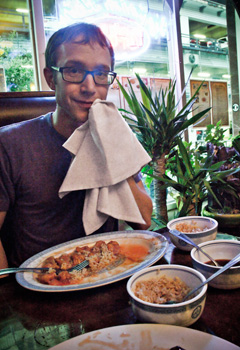 story by tyler weaverDo you ever wonder about napkins? I’m Tyler the Trash Guy, so I think about them constantly. Napkins are almost universally perceived as cost-free items that can be liberally obtained in any quantity, without question. Why do you need napkins? Do you spill food at every sitting? (Do people think I’m dirty for denying them any chance I get?)
story by tyler weaverDo you ever wonder about napkins? I’m Tyler the Trash Guy, so I think about them constantly. Napkins are almost universally perceived as cost-free items that can be liberally obtained in any quantity, without question. Why do you need napkins? Do you spill food at every sitting? (Do people think I’m dirty for denying them any chance I get?)
In my waste-free utopia, napkins wouldn’t be provided unless asked for, with businesses in full control of how many are dispensed. Consider this: How many times have you either taken or received napkins with a meal, only to throw most or all of them, unused, in the trash when you’re finished eating? Over the last few weeks, I’ve been observing people when they get up to leave a restaurant. I notice that unused napkins almost always get trashed.
Though individually small, napkins contribute in a big way to our wasteful habits. In fact, paper makes up a whopping 40 percent of our landfills. It is the most prevalent material disposed, exceeding plastic bottles, diapers, food waste and appliances combined. Think about it this way: For as long as you’ve been on the planet, the process for making paper hasn’t really changed, while advances in technology and production processes have stripped glass and plastics (bags and bottles alike) of nearly half their weight and thickness.
Because products like napkins, paper towels and phonebooks are made almost exclusively of recycled (low-grade) material, they’re not candidates for further recycling, but they’re definitely compostable, and there’s no need for them to end up in the landfill.
What can you do?
The next time you’re in a restaurant or at a lunch truck, I’d like you to ask yourself this: Do I really need all those napkins? See what happens when you pocket those extra napkins and tell the server to hold off on any more. Remember cloth napkins? Some bars and restaurants still use them; that’s a good practice to support. If you’re at an establishment using paper napkins, politely ask if they’ve considered the cloth alternative.
This might be a stretch, but whatever happened to handkerchiefs? Here’s a trend—essentially a portable, reusable napkin—that once hung proudly out of people’s back pockets.
This one might sound extreme, but I’m going to throw it out there anyway: Have you tried drying your hands by placing them surreptitiously into your pockets after washing them? It works. (So does just simply letting them air dry.)
The impact of paper products may seem trivial, but they contribute much more to the waste system than most of us realize. You have the power to change that. So, go for it. Challenge yourself to use fewer napkins and paper towels. It doesn’t make you dirtier (though briefly moister); it makes you a more mindful and in-tune global citizen.
Tyler’s Tips
Individuals
Invest in cloth handkerchiefs and napkins. For the paper products you can’t replace, choose those made from 100 percent recycled material—the more people buy, the more material will be recycled. Greenline (greenlinepaper.com) and Marcal (marcalsmallsteps.com)
are leaders.
Businesses
Look into linen services to provide your napkins and towels. Wash Cycle Laundry (washcyclelaundry.com) is a Center City company offering these services, all delivered via bicycle.
Tyler Weaver is a garbage and compost expert who’s been obsessed with waste since he climbed into his first Dumpster two decades ago. Read more of his musings at tylertalkstrash.com and
crazyaboutcompost.com.

